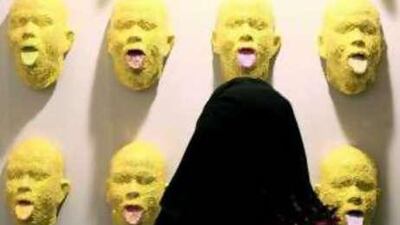There wasn't a consensus about much at the preview of this year's artparis-AbuDhabi fair. Indeed, the gorgeous halls of the Emirates Palace resounded with good-natured disagreement: was business booming or were the preview crowd just a lot of very well-dressed window shoppers? Though definitive answers were scarce, one could find as many opinions as pundits. However, on two points, gallerists and visitors alike were in agreement. Firstly, the standard of work on display at this year's event was greatly superior to that at 2007's inaugural show: the galleries had come with reinforcements, and they had brought their big guns. At times it seemed one could barely move for Warhols - surely he was the best represented artist on the floor. There were also valuable pieces from such comparative immortals as Chagall, Cezanne and Picasso, and excellent work from big contemporary names at every turn.
The second uncontroversial feature of the fair was that the visitors this year seemed, on average, younger, savvier and more excited by art than their predecessors. Art advisors were out in force, and several gallerists remarked on a greater sense of intellectual engagement compared with last year. In the words of Peter Femfert, the founder of Die Galerie: "the Emirates have very good knowledge nowadays. They have advisers. They know about quality." This may only reflect a new degree of cautiousness, of course: in a difficult financial climate, few buyers can afford to speculate on a whim. Nevertheless, there seemed little doubt that artparis-AbuDhabi had graduated to a new level of seriousness.
The fair, however, represents only the focal point in an impressive schedule of cultural events. At the opening of the Collectors' Programme on Sunday, the British-Iraqi architect Zaha Hadid, the Iranian artist Shirin Neshat, and the curators Rose Issa and Saleh Barakat were among the dignitaries mingling beneath the stars on the Emirates Palace beach terrace, grazing at the beluga-filled buffet and making whatever amounts to small talk at such intellectual altitudes.
At the same time, a host of well-known European gallerists including Yoyo Maeght joined Dominique de Villepin, France's former prime minister, and Saqr Ghobash, the Minister for Labour, for a rather more sedate affair at the InterContinental following a conference on Charles de Gaulle organised by the Sorbonne. The biggest talking point, however, was the sheer range of international talent the fair brought together. As Raymond Foye from Jablonka art gallery remarked: "works at this art fair are simply more beautiful, more visually beautiful than at most art fairs. Some of the more difficult, conceptual, cerebral and intentionally shocking work isn't here, and, frankly, it makes for a much more enjoyable art fair."
Indeed, the few more conceptual pieces did seem oddly out of place against the decorative, calligraphic tone of many Arabic contributions. Tony Oursler's Blob, for instance, in which women's dislocated facial features recite Bruce Naumann-style slogans while being projected onto an amorphous lump of white plastic, simply seemed like it had come to the wrong party. Perhaps it should have brought a few more gatecrashers along for the ride: if the fair has a fault, it's that it errs a little too much on the side of polite good taste.
Still, the nearest thing I heard to a cavilling note all evening came from a prospective buyer who worried about the prices of some lesser-known Middle Eastern artists. Without having established western reputations to trade on, he said, they would find it difficult to crack European markets at their current asking prices. Observe the concern of the fox for the chickens. What were the standouts? Impossible to choose, though Melodie Mousset's writhing Möbius snake sculpture, Koon, has a strenuousness about it which can't help but draw the gaze; the name presumably refers to the Laocöon group to which it bears a passing resemblance. Nano Warsono, a young Javan artist exhibiting at Langgeng as part of the Young Talent series, approaches mythological and pop-cultural icons with a queasily lurid graphic style reminiscent of Robert Crumb. See if you can work out what the connection is meant to be between Zeus and the Smurfs in his painting titled The Family Reunion. And during a mild evening, there can be few more delightful places to wander than in the Monumental Sculpture Garden, listening as music and conversation float across from the collectors' lounge.
elake@thenational.ae

